AI agents are rapidly transforming industries across the board, bringing new opportunities for intelligent automation and efficiency. Companies like Salesforce with AgentForce, OpenAI with Agent Swarm, and NVIDIA with Agent Blueprints are leading the charge, but the shift is accessible to all businesses looking to innovate.
In this blog, we’ll draw on our extensive experience with AI consulting—from presenting AI agent workshops to Fortune 100 companies to building the apps you use every day—to explore the key frameworks, tools, and strategies needed to deploy AI agents effectively. Whether you're just starting your AI journey or you’re optimizing existing processes, Bitovi can guide you through the complexities, delivering tailored solutions that drive real impact.
Table of Contents
1. What are AI agents?
AI agents are autonomous systems designed to perceive, reason, and act within an environment to achieve specific goals. Unlike traditional automation, these agents can adapt and tackle complex tasks autonomously, significantly reducing human intervention. By utilizing AI agents, businesses can achieve greater efficiency, scalability, and round-the-clock operations, enhancing productivity across various domains.
Curious about how AI agents could revolutionize your operations? Learn more by joining our AI agents workshop.
2. Setting goals and use cases for AI agents
Setting well-defined goals is the foundation of successful AI agent implementation. Consider a scenario where a company aims to enhance relationships with its VIP clients. They need a clear objective aligned with broader business goals. The best way to ensure success is to implement a S.M.A.R.T. goal.
For example, what if the company set a goal to increase client outreach and engagement by building LLM-powered automation? The aim is to identify notable events related to VIPs from a predefined list (starting with a HubSpot VIP list) and notify the team via Slack.
.png?width=800&height=292&name=AI%20Agents%20Workflow%20(1).png)
This goal can be structured to be Specific, Measurable, Achievable, Relevant, and Time-bound:
-
Specific: The automation should identify notable events related to VIPs and send alerts to the team.
-
Measurable: Track at least 5-10 notable events weekly.
-
Achievable: Use data from key sources like LinkedIn, company blogs, and Google News.
-
Relevant: Strengthen client relationships through timely outreach.
-
Time-bound: Set a timeframe to achieve this, such as within six months of deployment.
To track the success of the AI automation, several key performance indicators (KPIs) should be identified:
-
Number of VIP profiles monitored weekly: How many VIPs are being tracked by the automation.
-
Number of notable events flagged: Track the number of important events that the automation identifies for further action.
-
Response rate: Measure how frequently the flagged events lead to actionable outreach.
These metrics provide tangible data to understand if the automation is truly adding value to the VIP engagement strategy.
This goal and its related KPIs allow for building an AI agent that not only meets operational needs but also fosters meaningful interactions with VIPs. By measuring aspects like the accuracy of flagged events and the speed at which the team responds, the automation can be refined, and the overall strategy improved.
Are you ready to create meaningful AI solutions for your business? Join our AI agents workshop and take the first step toward impactful AI integration.
3. AI Agent system requirements and constraints
Deploying AI agents requires a solid understanding of system requirements and potential challenges. Successful AI agent implementation depends on ensuring compatibility with enterprise-specific systems, managing security policies, and addressing networking considerations, among other factors.
Key System Requirements to Consider
-
Access to Proprietary Systems: Ensuring that AI agents can interact with the necessary internal systems, which often requires specific API access and integrations.
-
Security Policies and Compliance: Adhering to organizational security policies is crucial for AI deployments. This includes implementing strict access controls, data encryption, and ensuring compliance with industry standards.
-
Networking Considerations: Agents must operate seamlessly within existing network configurations, including managing firewall permissions, IP whitelisting, and secure data transmission protocols.
-
Data Privacy: Proper handling of sensitive and proprietary information is essential. AI agents need access to data without compromising confidentiality.
-
Approval Workflows: Integration with existing approval processes to maintain compliance with organizational standards and governance.
-
Reliable Systems: Implementing high availability (HA) and disaster recovery (DR) ensures that if a data center goes down, systems remain active or can recover without data loss.
-
System Visibility: Understanding how the infrastructure and agent systems are performing is crucial for maintaining operational efficiency.
Key Constraints to Manage
-
Scalability Challenges: Ensuring that the AI agent can handle increased workloads as the organization grows.
-
Integration with Legacy Systems: Compatibility issues may arise when integrating AI agents with outdated systems.
-
Data Privacy: Proper handling of sensitive information is crucial to prevent data breaches.
-
Computational Costs: Managing the costs associated with the computing power needed for AI operations.
-
Organizational Governance Policies: Aligning AI agent actions with the existing governance and compliance policies of the organization.
Learn how to effectively manage these system challenges—our AI agents workshop will guide you through every step.
4. What’s the difference between AI Agents and traditional automation?
Traditional automation systems rely on rigid workflows and require significant maintenance, especially when novel issues arise. This rigidity often leads to higher operational costs, slower response times, and scalability challenges.
Problems with traditional automation
-
Rigid Workflows: Traditional automation lacks flexibility, requiring predefined scripts that need manual adjustments.
-
High Maintenance: Significant effort is required to maintain workflows, especially when handling unique or unforeseen situations.
-
Limited Adaptability: Traditional systems struggle to adapt to changes in real-time, requiring extensive human oversight, which becomes particularly problematic as team sizes and demands grow.
Example of a traditional workflow:
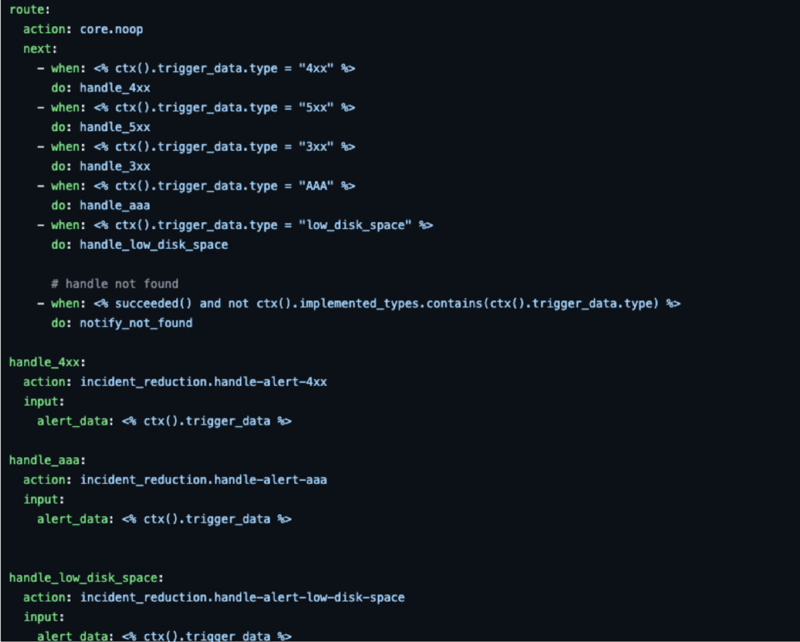
Benefits of AI agents
AI Agents are essentially: Tools + Reasoning.
.png?width=800&height=313&name=AI%20Agent%20Virtues%20(2).png)
To move beyond traditional auto-remediation, AI Agents provide the following
-
Swift Team and Tool Onboarding: Natural language interactions make it easier for people to implement their own functionality and use cases.
-
Intelligent Reasoning: AI agents can handle exceptions by applying contextual understanding and adaptive decision-making.
-
Adaptive Learning: Unlike traditional systems, AI agents learn from past experiences, continuously improving their efficiency and capabilities.
-
Natural Language Interactions: AI agents interact with users using natural language, simplifying communication and reducing the need for specialized technical input.
In short, humans are often the bottleneck in traditional automation systems, limiting scalability and flexibility. With intelligent LLM-driven AI agents, businesses can overcome these limitations, enabling more efficient operations, real-time decision-making, and significantly reducing manual interventions.
As an example, consider an auto-remediation scenario in IT support. In a traditional setup, automation would rely on predefined scripts to handle incidents, such as restarting a server or clearing a specific error. However, if the issue diverges from the expected pattern, manual intervention would be needed. In contrast, AI agents could dynamically diagnose and resolve issues by analyzing context in real-time, identifying the root cause, and taking appropriate actions. This ability to adapt and respond without explicit human input makes AI agents a more versatile and scalable solution for evolving business needs.
Experience the difference AI agents bring—sign up for our AI agents workshop to explore new automation possibilities.
5. Frameworks and tools for AI agents
Choosing the right frameworks and tools is crucial for building and deploying AI agents effectively. The criteria for selecting an agent framework include supporting approvals and feedback mechanisms, ensuring steerability and security, maintaining memory for context, and enabling tool integration, among others.
Popular AI agent frameworks
-
CrewAI: Focused on collaborative agent development.
-
LangGraph: Supports graph-based reasoning and workflows.
-
N8N: A low-code platform for workflow automation.
Others, such as Semantic Kernel and MS AutoGen, have their own strengths. Additionally, you can build a custom solution tailored to your specific needs.
Our criteria for selecting frameworks were essentially: how swiftly can we move reliably?
We first tried collaborative agents through CrewAI. In our experience, collaborative agents can be challenging to steer with today's models—prompting needs to be quite verbose for less intelligent models, and there comes a point when it feels like writing code would be more effective. CrewAI still has its strengths and can be highly effective in certain collaborative agent scenarios (higher creativity scenarios, like sales or marketing agents, for example).
We turned to LangGraph and found that, due to the graph-based approach's flexibility, we could move more quickly while relying on some rigidity.
Additional Benefits of LangGraph
-
Community Support: Access to documentation, examples, and active support channels.
-
Utilities: Includes functions, memory, and prebuilt solutions like reAct agents.
-
Flexible Reasoning: Ability to incorporate a variety of reasoning strategies, making it adaptable to different workflows.
For even faster iteration, consider using N8N. N8N is a user-friendly, low-code automation tool that provides numerous templates and a wide range of integrations. It also has a visually appealing, graph-based interface and is open source—which we love at Bitovi.
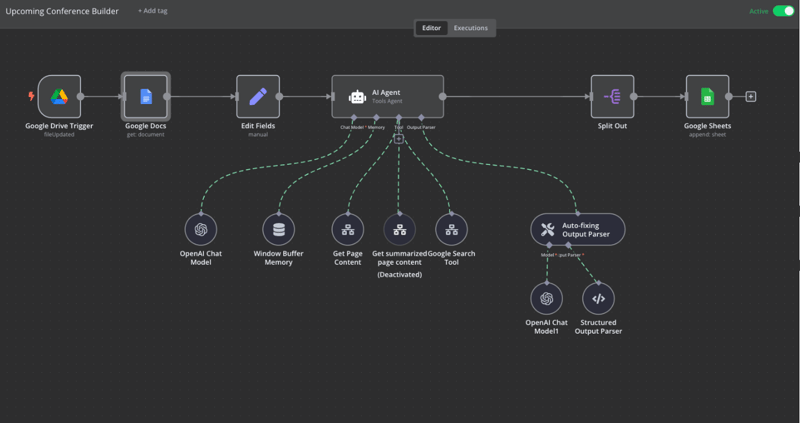
Additional Benefits of N8N
-
Community Support and Flexibility: Similar benefits to LangGraph.
-
Snazzy UI: Creating and executing agent workflows is fun because the UI is intuitive and visually appealing.
-
Triggers: It supports various triggers, which enables automation to be highly responsive to different events.
-
Lots of Connections: Numerous pre-built integrations with other tools and services make it highly versatile.
Using LangGraph and N8N together can be an effective combination for creating flexible agent workflows with intuitive interfaces.
Want to find the perfect tools to build your AI agents? Our AI agents workshop will help you choose and configure the right frameworks.
6. Reasoning strategies for AI Agents
AI agents employ a variety of sophisticated reasoning strategies to solve complex problems. These strategies enable agents to autonomously address different scenarios, improve their performance over time, and efficiently manage complex tasks. Here are a few key reasoning strategies used by AI agents:
Multi-Agent Collaboration: Teams of agents working collaboratively to complete tasks by communicating and sharing knowledge.

IMG based on Langchain
Agent Supervisor: Agents work collaboratively under the guidance of a supervisory agent, which ensures that tasks are completed correctly.

Hierarchical Teams: A multi-layered approach where agents work under different layers of supervisors, creating an organized workflow.
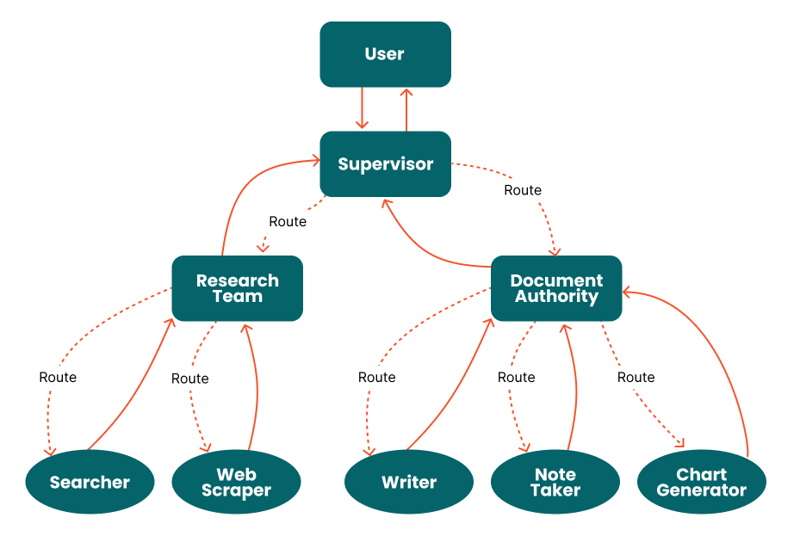
Plan and Execute: Agents generate a detailed plan to achieve a goal and execute steps iteratively, reevaluating and replanning if necessary.
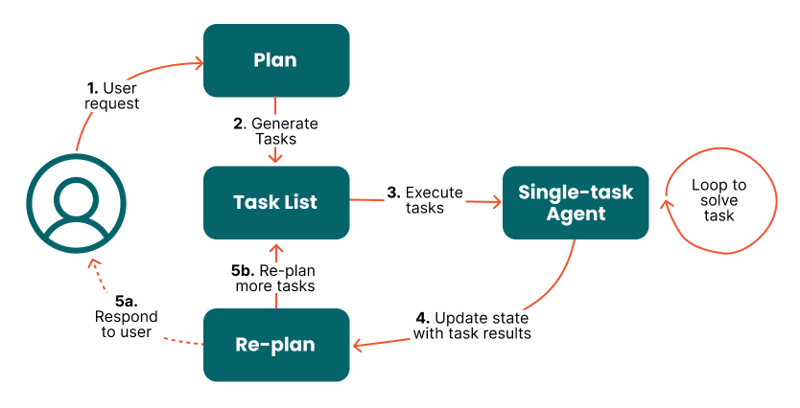
Self-Discovery: Agents identify the appropriate strategy to address a problem effectively based on the nature of the request.
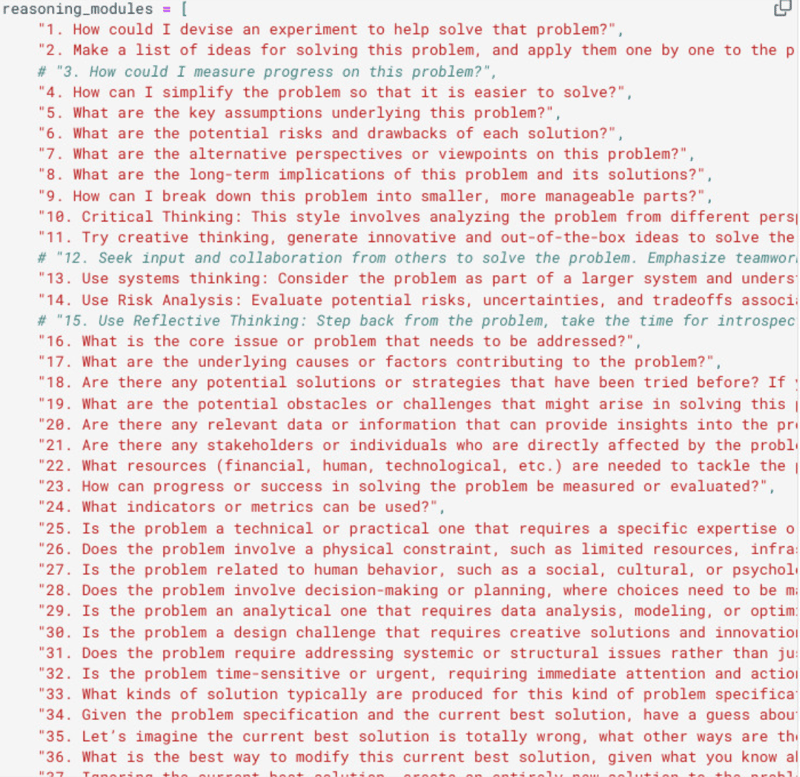
Choosing the right reasoning strategy depends on the specific context and the nature of the task at hand. With the right framework, you can easily experiment with various strategies to determine which is most effective for your use case.
Want to see these reasoning strategies in action? Our AI agents workshop is the place to start—register now and unlock these insights.
7. System orchestration and AI agent frameworks
System orchestration ensures AI agents operate smoothly by managing events, tracking job states, and ensuring data resilience. A well-defined orchestrator plays a key role in enabling the effective operation of AI agents, especially in complex enterprise environments.
Orchestrators and their benefits
-
Temporal: Provides advanced workflow orchestration capabilities, allowing for complex task sequencing and long-term state management.
-
StackStorm: Focuses on event-driven automation, making it ideal for integrating various IT tools and services in response to different triggers.
-
Kafka: A distributed streaming platform effective for real-time data processing and event tracking.
-
AWS Lambda: A serverless compute service that helps manage functions on demand, ideal for scaling agent tasks without maintaining infrastructure.
Each of these orchestrators offers unique capabilities to support agent-based workflows, such as managing task dependencies, coordinating distributed processes, and ensuring resilience in case of failures.
Discover how to orchestrate AI agents effectively—join our AI agents workshop and get hands-on experience.
8. User interface and experience
The interaction layer plays a critical role in the successful implementation of AI agents, as it directly influences the quality of user experience (UX). A well-designed UX ensures that AI agents are functional, intuitive, and easy to interact with, making them more effective in achieving user goals.
Best UX patterns for AI agents
-
Anthropic's Claude Artifacts: Designed to provide clear, insightful responses while maintaining user engagement.
-
OpenAI's Canvas: Offers an adaptable workspace where users can interact with AI in a dynamic and creative manner.
-
GitHub Copilot and Cursor Tabbing: Uses intuitive interaction methods, like code suggestions and cursor navigation, to create a more streamlined development experience.
Agents can also provide a more transparent user experience. For example, the user experience for several of Bitovi's agents is simply: edit a Google Doc, receive recommendations in a Google Sheet.
To take it a step further, AI agents can adopt nearly any substrate for user interactions. Substrate in this context refers to a location that manages a thread of interaction. Examples include:
-
GitHub issues and comments
-
Emails and replies
-
Jira tickets and comments
-
Slack threads
At Bitovi, we use Slack due to its flexibility, natural language capabilities, and wide range of integrations. To illustrate, take a look at this example diagnostics message in response to an error alert:
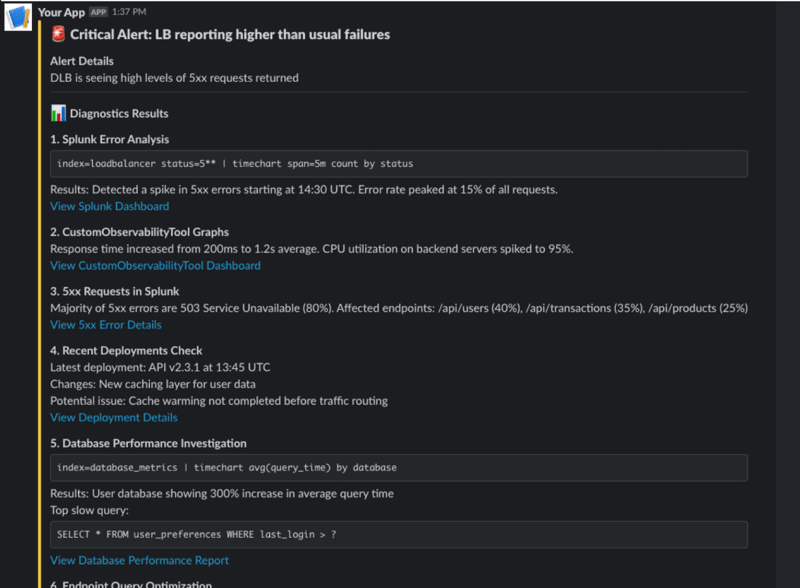
Custom interfaces like Streamlit or Chainlit can also be used for advanced UI controls, providing flexibility beyond pre-existing platforms. Messaging substrates such as Google Docs, Sheets, HubSpot, and Jira offer multiple options for integrating AI agents into existing workflows.
Ready to revolutionize how your team interacts with AI? Sign up for our AI agents workshop and explore innovative UI/UX strategies.
9. Observability
Observability is crucial for understanding and managing the performance of AI agents. It involves monitoring system metrics, tracking agent interactions, and assessing overall outcome visibility. Effective observability ensures that potential issues are identified early, and performance bottlenecks are resolved promptly. By implementing robust observability practices, organizations can gain real-time insights into the functioning of their AI agents, ensuring they are meeting operational goals and effectively supporting business processes.
Key Aspects of Observability for AI Agents
-
System Metrics Monitoring: Track CPU usage, memory consumption, and latency to ensure that the underlying infrastructure supporting AI agents is performing efficiently.
-
Agent Interaction Tracking: Monitor how AI agents interact with users, systems, and data sources. This helps in understanding how effectively the agents are processing requests and executing tasks.
-
Outcome Visibility: Assess the results generated by AI agents to determine if they are meeting the desired performance standards and aligning with business objectives.
For example, in the VIP client engagement use case, observability tools help track the number of notable events flagged by the AI agent, monitor how promptly the team responds, and assess the overall impact on client relationships. This data-driven approach provides transparency and enables continual improvement of the AI agent's effectiveness in achieving the set S.M.A.R.T. goals.
Tools like LangSmith and LangFuse provide valuable insights into agent behavior, enabling data-driven decisions, improving transparency, and facilitating continual optimization of agent workflows.
Want to enhance observability and make data-driven improvements? Our AI consulting services can help identify ways to drive value with AI.
10. Data acquisition for AI agents
The quality of an AI agent's performance heavily depends on the quality, accuracy, and relevance of the data it has access to. Data acquisition is a critical step in building and optimizing AI agents, as it forms the basis of the agent's decision-making capabilities. There are several methods of data acquisition for AI agents, each serving different needs and ensuring that the agent can perform at its best across a wide variety of tasks. Proper data acquisition strategies help ensure that the AI agent can provide precise, relevant, and timely responses, thereby meeting operational goals and contributing to the broader strategic objectives of the organization:
-
Real-Time Lookup: This involves direct API integrations to access data instantly when required. Real-time data lookup is particularly useful in scenarios where up-to-date information is crucial, such as monitoring current events or tracking recent activities related to VIP clients. It ensures that the AI agent always has the latest information to work with, allowing it to respond accurately to dynamic situations.
-
ETL Processes: Extract, Transform, and Load (ETL) processes are used to gather structured data from various sources, transform it into a usable format, and load it into a centralized database for AI decision-making. ETL is essential when dealing with large volumes of data from multiple disparate sources, such as customer relationship management (CRM) systems, email logs, and social media, to name a few that are relevant to our S.M.A.R.T. goal from before. By transforming and organizing this data, ETL helps AI agents access relevant information quickly and generate informed outputs, supporting more targeted and strategic decision-making.
-
Vectorization: Vector databases are used to store data in a way that enables semantic understanding and improved search capabilities. Vectorization involves converting textual data into numerical vectors, which makes it easier for AI agents to perform similarity searches and retrieve information based on contextual meaning. This approach is particularly effective for tasks like document retrieval or identifying similar topics, which is crucial in use cases such as analyzing industry trends or gathering contextually relevant information for VIP client engagement.
For instance, in the VIP client engagement use case, ETL processes could be used to gather customer data from platforms like LinkedIn, Google News, and internal CRM systems. By consolidating and transforming this data, the AI agent can generate targeted outreach content and identify notable events related to VIP clients, ensuring that engagement strategies are well-informed and timely. This data-driven approach helps in achieving S.M.A.R.T. goals, such as improving client relationships through consistent and meaningful interaction.
Curious about how to optimize data acquisition for AI? Sign up for our AI agents workshop and get started.
11. Retrieval Augmented Generation (RAG)
Retrieval Augmented Generation (RAG) is a sophisticated approach used by AI agents to enhance responses by incorporating relevant context retrieved from large datasets. RAG works by dynamically querying external databases, knowledge bases, or document repositories to bring in supplementary information that enriches the response quality. This augmentation process involves ranking documents based on their relevance to the initial query, ensuring that the AI agent provides the most contextually appropriate answers. By retrieving context-rich information, RAG enables the AI to generate more accurate, complete, and informative responses, bridging the gap between general language models and specific, up-to-date knowledge.
Key Benefits of Retrieval Augmented Generation (RAG)
-
Enhanced Response Accuracy: By accessing specific, relevant information from trusted sources, RAG significantly improves the precision of AI responses.
-
Dynamic Querying for Context: RAG allows AI agents to query in real time, ensuring that the information provided is up-to-date and aligned with the context of the question.
-
Reduced Hallucination: Language models sometimes generate responses based on assumptions, leading to inaccurate information. RAG mitigates this issue by grounding responses in reliable retrieved documents.
-
Scalable Knowledge Integration: RAG provides a scalable method for integrating vast amounts of knowledge into AI responses without the need for constant model retraining.
-
Flexible Application: RAG is suitable for various use cases, including customer service, technical support, and knowledge management, as it can provide tailored information efficiently.
For example, in the VIP client engagement use case, RAG can help AI agents retrieve relevant information from sources like LinkedIn, company blogs, and Google News to identify notable events related to VIP clients. By quickly gathering, synthesizing, and ranking information, RAG ensures that the most relevant updates are flagged and shared with the team for timely outreach.
By utilizing RAG, AI agents can effectively bridge the gap between generalized language understanding and specific, context-aware information retrieval, which makes them far more valuable in specialized domains and real-world applications.
Interested in boosting your AI's intelligence with RAG? Our AI agents workshop will show you how—sign up now.
12. Getting started with AI agents
Implementing AI agents involves understanding the potential constraints, assessing the fit within your organization, and setting realistic expectations. Identifying use cases that align with strategic KPIs, such as reducing ticket resolution time or increasing customer satisfaction, is crucial to realizing the value of AI agents.
Whether it's auto-remediation, marketing automation, or DevOps, getting started with AI agents requires a clear roadmap and strategic vision. Our AI consulting team can help you get started implementing AI where it counts for your business.
Conclusion
AI agents are revolutionizing the way businesses operate, delivering smarter automation, real-time insights, and scalable efficiency. With the right frameworks, clear goals, and robust observability, you can drive meaningful impact with AI agents.
At Bitovi, we know what it takes to implement AI solutions that work. Whether you’re just starting or fine-tuning existing processes, we’re here to help you cut through the complexity and unlock real results.
Ready to transform your business? Join our AI agents workshop and lead the charge with AI agents built for impact.
Previous Post




